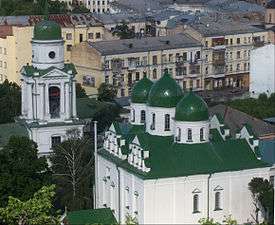Florivsky Convent
- For the eponymous monastery in Moscow, see Ascension Convent

The Ascension Convent in the Kievan neighbourhood of Podil, better known as the Florivsky or Florovsky Monastery (Russian: Флоровский монастырь), originated in the 16th century as the wooden church of Sts. Florus and Laurus. Its buildings occupy the slopes of the Zamkova Hora. Address: Frolovskaya ulitsa, 8.
The convent greatly expanded at the time of the Great Northern War, when Peter the Great ordered the demolition of the old Ascension Convent on Pechersk Hill with the aim of building an arsenal there. When run by Ivan Mazepa's mother, the older convent had amassed much property.[1] Its riches and nuns were transferred to the Florovsky Convent.
The main church, or katholikon, is a notable example of Ukrainian Baroque architecture.[2] Its first stone was laid in 1722. Ten years later, the three-domed building was dedicated to the feast of the Ascension of Christ. Its Neoclassical bell-tower is of later construction.
The wooden buildings of the monastery were entirely destroyed by fire in 1811. Only the katholikon and a 17th-century refectory were left standing amid the ashes. It was Andrey Melensky, a Neoclassical architect from Kiev, who was in charge of the convent's reconstruction.[1]
The convent's notable residents included Princess Natalia Dolgorukova, one of the first Russian women writers.[1] It was closed in 1929 but reopened after the Germans entered the city in 1941. Several buildings have since been taken over by industrial enterprises.[1]
References
Coordinates: 50°27′45″N 30°30′53″E / 50.46240°N 30.51471°E